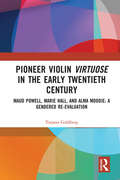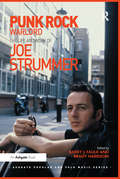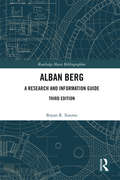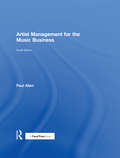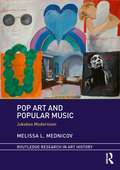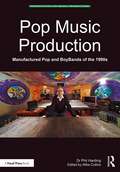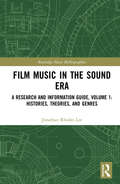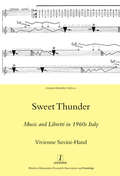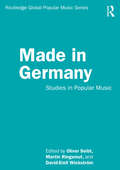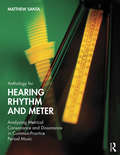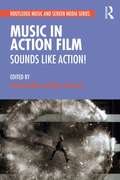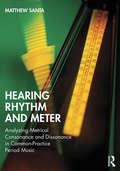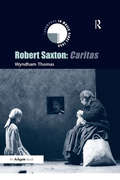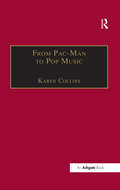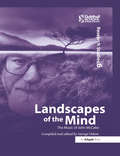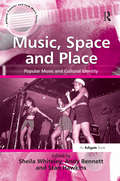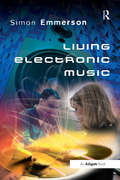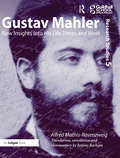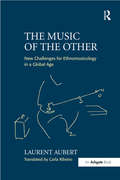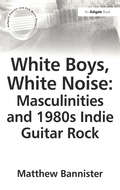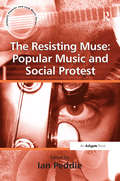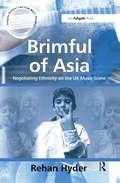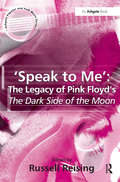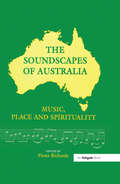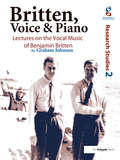- Table View
- List View
Pioneer Violin Virtuose in the Early Twentieth Century: Maud Powell, Marie Hall, and Alma Moodie: A Gendered Re-Evaluation
by Tatjana GoldbergTatjana Goldberg reveals the extent to which gender and socially constructed identity influenced female violinists’ ‘separate but unequal’ status in a great male-dominated virtuoso lineage by focussing on the few that stood out: the American Maud Powell (1867–1920), Australian-born Alma Moodie (1898–1943), and the British Marie Hall (1884–1956). Despite breaking down traditional gender-based patriarchal social and cultural norms, becoming celebrated soloists, and greatly contributing towards violin works and the early recording industry (Powell and Hall), they received little historical recognition. Goldberg provides a more complete picture of their artistic achievements and the impact they had on audiences.
Punk Rock Warlord: the Life and Work of Joe Strummer (Ashgate Popular and Folk Music Series)
by Barry J. Faulk Brady HarrisonPunk Rock Warlord explores the relevance of Joe Strummer within the continuing legacies of both punk rock and progressive politics. It is aimed at scholars and general readers interested in The Clash, punk culture, and the intersections between pop music and politics, on both sides of the Atlantic. Contributors to the collection represent a wide range of disciplines, including history, sociology, musicology, and literature; their work examines all phases of Strummer’s career, from his early days as ’Woody’ the busker to the whirlwind years as front man for The Clash, to the ’wilderness years’ and Strummer’s final days with the Mescaleros. Punk Rock Warlord offers an engaging survey of its subject, while at the same time challenging some of the historical narratives that have been constructed around Strummer the Punk Icon. The essays in Punk Rock Warlord address issues including John Graham Mellor’s self-fashioning as ’Joe Strummer, rock revolutionary’; critical and media constructions of punk; and the singer’s complicated and changing relationship to feminism and anti-racist politics. These diverse essays nevertheless cohere around the claim that Strummer’s look, style, and musical repertoire are so rooted in both English and American cultures that he cannot finally be extricated from either.
Alban Berg: A Research and Information Guide (Routledge Music Bibliographies #Vol. 38)
by Bryan R. SimmsAlban Berg: A Research and Information Guide, Third Edition is an annotated bibliography highlighting both the nature of primary sources related to the composer and the scope and significance of the secondary sources that deal with Berg, his compositions, and his influence as a composer. It is a reliable, complete, and useful resource and a starting point for anyone—performer, teacher, student, or scholar—wanting to learn about Berg’s life, works, and cultural milieu. The third edition has 162 additional citations since the publication of the second edition, many arising after the expiration of copyright of Berg’s musical and archival works 2005. Many important new, primary sources of information have appeared, most notably the letter exchanges with his wife, recently published in a three-volume critical edition (in German), as well as letter exchanges with Alma Mahler and Erich Kleiber, and later correspondences with Anton Webern. There has also been a notable increase in the availability of commercial video recordings of Berg's operas, Wozzeck and Lulu.
Artist Management for the Music Business
by Paul AllenAnyone managing an artist’s career needs to be well versed and have a savvy understanding of the moving parts of the music business. You’ll learn how and why those moving parts "move," as well as how to manage and navigate a music-based career. Artist Management for the Music Business gives you a comprehensive view of how to generate income through music and how to strategically plan for future growth. The book is full of valuable practical insights. It includes interviews and case studies with examples of real-world management issues and outcomes. Updates to this new edition include the importance of online streaming to music careers, how anyone can effectively network, tools for successful negotiation, ways to identify and manage income sources, and guidance on the ever-changing social media landscape of the music business. This book gives you access to resources about artist management and the music business at its companion website, http://www.artistmanagementonline.com. There is no login, and the resources are updated regularly.
Pop Art and Popular Music: Jukebox Modernism (Routledge Research in Art History)
by Melissa L. MednicovThis book offers an innovative and interdisciplinary approach to Pop art scholarship through a recuperation of popular music into art historical understandings of the movement. Jukebox modernism is a procedure by which Pop artists used popular music within their works to disrupt decorous modernism during the sixties. Artists, including Peter Blake, Pauline Boty, James Rosenquist, and Andy Warhol, respond to popular music for reasons such as its emotional connectivity, issues of fandom and identity, and the pleasures and problems of looking and listening to an artwork. When we both look at and listen to Pop art, essential aspects of Pop’s history that have been neglected—its sounds, its women, its queerness, and its black subjects—come into focus.
Pop Music Production: Manufactured Pop and BoyBands of the 1990s (ISSN)
by Phil HardingPop Music Production delves into academic depths around the culture, the business, the songwriting, and most importantly, the pop music production process. Phil Harding balances autobiographical discussion of events and relationships with academic analysis to offer poignant points on the value of pure popular music, particularly in relation to BoyBands and how creative pop production and songwriting teams function.Included here are practical resources, such as recording studio equipment lists, producer business deal examples and a 12-step mixing technique, where Harding expands upon previously released material to explain how ‘Stay Another Day’ by East 17 changed his approach to mixing forever. However, it is important to note that Harding almost downplays his involvement in his career. At no point is he center stage; he humbly discusses his position within the greater scheme of events. Pop Music Production offers cutting-edge analysis of a genre rarely afforded academic attention.This book is aimed at lecturers and students in the subject fields of Music Production, Audio Engineering, Music Technology, Popular Songwriting Studies and Popular Music Culture. It is suitable for all levels of study from FE students through to PhD researchers. Pop Music Production is also designed as a follow-up to Harding’s first book PWL from the Factory Floor (2010, Cherry Red Books), a memoir of his time working with 1980s pop production and songwriting powerhouse, Stock Aitken Waterman, at PWL Studios.
Film Music in the Sound Era: A Research and Information Guide, Volume 1: Histories, Theories, and Genres (Routledge Music Bibliographies)
by Jonathan Rhodes LeeFilm Music in the Sound Era: A Research and Information Guide offers a comprehensive bibliography of scholarship on music in sound film (1927–2017). Thematically organized sections cover historical studies, studies of musicians and filmmakers, genre studies, theory and aesthetics, and other key aspects of film music studies. Broad coverage of works from around the globe, paired with robust indexes and thorough cross-referencing, make this research guide an invaluable tool for all scholars and students investigating the intersection of music and film. This guide is published in two volumes: Volume 1: Histories, Theories, and Genres covers overviews, historical surveys, theory and criticism, studies of film genres, and case studies of individual films. Volume 2: People, Cultures, and Contexts covers individual people, social and cultural studies, studies of musical genre, pedagogy, and the Industry. A complete index is included in each volume.
Sweet Thunder: Music and Libretti in 1960s Italy
by Vivienne Suvini-Hand"Italian music of the 1960s is one of the most unjustly neglected areas in the arena of twentieth-century classical music. This volume pays tribute to the astounding complexity of the music and libretti of five vocal compositions by leading experimental composers of the decade: Luigi Dallapiccola, Bruno Maderna, Luciano Berio, Giacomo Manzoni, and Armando Gentilucci. It highlights how the 'difficult' and unconventional methods of composition employed by these artists - dodecaphony, total serialism, Webernian minimalist techniques, aleatory and electronic music - displayed a refusal to compete with the market-place values of Italy's new capitalist society. At the same time, the libretti's collage arrangement of a plethora of European and Oriental literary sources dating from the sixteenth century BC onwards, reflected the contemporary Neo-avant-garde rejection of conventional literary practice, and their preference for 'organised disorder', in Umberto Eco's phrase."
Made in Germany: Studies in Popular Music (Routledge Global Popular Music Series)
by Oliver SeibtMade in Germany: Studies in Popular Music serves as a comprehensive introduction to the history, sociology, and musicology of contemporary German popular music. Each essay, written by a leading scholar of German music, covers the major figures, styles, and social contexts of pop music in Germany and provides adequate context so readers understand why the figure or genre under discussion is of lasting significance. The book first presents a general description of the history and background of popular music in Germany, followed by essays organized into thematic sections: Historical Spotlights; Globally German; Also "Made in Germany"; Explicitly German; and Reluctantly German.
Anthology for Hearing Rhythm and Meter
by Matthew SantaThis full-score anthology for Hearing Rhythm and Meter: Analyzing Metrical Consonance and Dissonance in Common-Practice Period Music supports the textbook of the same name, the first book to present a comprehensive course text on advanced analysis of rhythm and meter. From the Baroque to the Romantic era, Hearing Rhythm and Meter emphasizes listening, enabling students to recognize meters and metrical dissonances by type both with and without the score. Found here are masterworks carefully chosen as the ideal context for the presentation of foundational concepts. PURCHASING OPTIONS Textbook (Print Paperback): 978-0-8153-8448-9 Textbook (Print Hardback): 978-0-8153-8447-2 Textbook (eBook): 978-1-351-20431-6 Anthology (Print Paperback): 978-0-8153-9176-0 Anthology (Print Hardback): 978-0-367-34924-0 Anthology (eBook): 978-1-351-20083-7
Music in Action Film: Sounds Like Action!
by James Buhler Mark DurrandMusic in Action Film is the first volume to address the central role of music and sound in action film—arguably the most dominant form of commercial cinema today. Bringing together 15 essays by established and emerging scholars, the book encompasses both Hollywood blockbusters and international films, from classic works such as The Seven Samurai to contemporary superhero franchises. The contributors consider action both as genre and as a mode of cinematic expression, in chapters on evolving musical conventions; politics, representation, and identity; musical affect and agency; the functional role of music and sound design in action film; and production technologies. Breaking new critical ground yet highly accessible, this book will be of interest to students and scholars of music and film studies.
Hearing Rhythm and Meter: Analyzing Metrical Consonance and Dissonance in Common-Practice Period Music
by Matthew SantaHearing Rhythm and Meter: Analyzing Metrical Consonance and Dissonance in Common-Practice Period Music is the first book to present a comprehensive course text on advanced analysis of rhythm and meter. This book brings together the insights of recent scholarship on rhythm and meter in a clear and engaging presentation, enabling students to understand topics including hypermeter and metrical dissonance. From the Baroque to the Romantic era, Hearing Rhythm and Meter emphasizes listening, enabling students to recognize meters and metrical dissonances by type both with and without the score. The textbook includes exercises for each chapter and is supported by a full-score anthology. PURCHASING OPTIONS Textbook (Print Paperback): 978-0-8153-8448-9 Textbook (Print Hardback): 978-0-8153-8447-2 Textbook (eBook): 978-1-351-20431-6 Anthology (Print Paperback): 978-0-8153-9176-0 Anthology (Print Hardback): 978-0-367-34924-0 Anthology (eBook): 978-1-351-20083-7
Robert Saxton: Caritas (Landmarks in Music Since 1950)
by Wyndham ThomasCaritas relates the 'true', yet largely undocumented story of Christine Carpenter, a 14th-century anchoress who moves towards insanity as her desire for a divine revelation continues to be unfulfilled after a period of three years locked in her cell. Although physically isolated, she is aware of the worldly life and love that she has abandoned. The very essence of the drama is the dogmatic refusal of her Bishop to release her from her vows. Set against the backcloth of the Peasants' Uprising (1381), the libretto/play juxtaposes sacred and secular worlds, the relative power and servitude of rulers and serfs, and the terrifying ordeal of Christine who is caught between the inflexibility of the established church and her personal religious expectations. Such a narrative was to offer rich opportunities for musical characterization and evocation of the historical context of the action, as well as substantial challenges in pacing and integrating the sequence of dramatic 'snap-shots' that culminate in a scene of total despair. The colourful juxtaposition of secular life and that of a recluse in Act One culminates in a Second Act finale of immense dramatic power in which Saxton's vocal and instrumental writing reaches new heights - a landmark both in his output and in late 20th century opera. Caritas - first performed in 1991 - occupies an important position in Robert Saxton's output and, as Thomas argues, in British opera during the closing decades of the 20th century. Thomas provides a detailed contextual setting in which to evaluate Caritas, as well as presenting an analytical commentary on the structure, musical language, instrumentation, staging and production of the opera. Thomas concludes with a reflection on the reception of Caritas as well as looking forward to Saxton's later and future works. A CD of the first performance is included.
From Pac-Man to Pop Music: Interactive Audio in Games and New Media (Ashgate Popular And Folk Music Ser.)
by Karen CollinsDigital interactive audio is the future of audio in media - most notably video games, but also web pages, theme parks, museums, art installations and theatrical events. Despite its importance to contemporary multi-media, this is the first book that provides a framework for understanding the history, issues and theories surrounding interactive audio. Karen Collins presents the work of academics, composers and sound programmers to introduce the topic from a variety of angles in order to provide a supplementary text for music and multimedia courses. The contributors cover practical and theoretical approaches, including historical perspectives, emerging theories, socio-cultural approaches to fandom, reception theory and case study analyses. The book offers a fresh perspective on media music, one that will complement film studies, but which will show the necessity of a unique approach when considering games music.
Landscapes of the Mind: The Music of John McCabe
by George OdamLiverpool-born composer and pianist, John McCabe, established himself as one of Britain's most recorded contemporary composers as well as a celebrated performer and recording artist. This book covers every aspect of his compositions and will help guide both general and specialist listeners and performers through the so-called landscapes of the mind that his music evokes. The title was suggested by McCabe himself and his composing and performing life took him on journeys all over the world through a variety of landscapes, many of which are to be found in essence in his music. The detailed discography will help readers to find recordings of many of the works described in the series of articles written by a collection of experienced critics, performers, broadcasters and reviewers, and the copious illustrations and full pages of musical score provide a variety of insights into McCabe's life and work.
Music, Space and Place: Popular Music and Cultural Identity (Ashgate Popular And Folk Music Ser.)
by Andy BennettMusic, Space and Place examines the urban and rural spaces in which music is experienced, produced and consumed. The editors of this collection have brought together new and exciting perspectives by international researchers and scholars working in the field of popular music studies. Underpinning all of the contributions is the recognition that musical processes take place within a particular space and place, where these processes are shaped both by specific musical practices and by the pressures and dynamics of political and economic circumstances. Important discourses are explored concerning national culture and identity, as well as how identity is constructed through the exchanges that occur between displaced peoples of the world's many diasporas. Music helps to articulate a shared sense of community among these dispersed people, carving out spaces of freedom which are integral to personal and group consciousness. A specific focal point is the rap and hip hop music that has contributed towards a particular sense of identity as indigenous resistance vernaculars for otherwise socially marginalized minorities in Cuba, France, Italy, New Zealand and South Africa. New research is also presented on the authorial presence in production within the domain of the commercially driven Anglo-American music industry. The issue of authorship and creativity is tackled alongside matters relating to the production of musical texts themselves, and demonstrates the gender politics in pop. Underlying Music, Space and Place, is the question of how the disciplines informing popular music studies - sociology, musicology, cultural studies, media studies and feminism - have developed within a changing intellectual climate. The book therefore covers a wide range of subject matter in relation to space and place, including community and identity, gender, race, 'vernaculars', power, performance and production.
Living Electronic Music
by Simon EmmersonDrawing on recent ideas that explore new environments and the changing situations of composition and performance, Simon Emmerson provides a significant contribution to the study of contemporary music, bridging history, aesthetics and the ideas behind evolving performance practices. Whether created in a studio or performed on stage, how does electronic music reflect what is live and living? What is it to perform 'live' in the age of the laptop? Many performer-composers draw upon a 'library' of materials, some created beforehand in a studio, some coded 'on the fly', others 'plundered' from the widest possible range of sources. But others refuse to abandon traditionally 'created and structured' electroacoustic work. Lying behind this maelstrom of activity is the perennial relationship to 'theory', that is, ideas, principles and practices that somehow lie behind composers' and performers' actions. Some composers claim they just 'respond' to sound and compose 'with their ears', while others use models and analogies of previously 'non-musical' processes. It is evident that in such new musical practices the human body has a new relationship to the sound. There is a historical dimension to this, for since the earliest electroacoustic experiments in 1948 the body has been celebrated or sublimated in a strange 'dance' of forces in which it has never quite gone away but rarely been overtly present. The relationship of the body performing to the spaces around has also undergone a revolution as the source of sound production has shifted to the loudspeaker. Emmerson considers these issues in the framework of our increasingly 'acousmatic' world in which we cannot see the source of the sounds we hear.
Gustav Mahler: New Insights into His Life, Times and Work
by Alfred Mathis-RosenzweigAlfred Mathis-Rosenzweig (1897-1948) was a Viennese musicologist and critic who studied at the universities of Budapest and Vienna. From 1933 he embarked on producing a large-scale study of Mahler but at the time of his death the manuscript was left unfinished. Although it was presumed lost until 1997, the unfinished typescript, written in German, had been deposited in the library of the Guildhall School of Music & Drama. In 2003, the School‘s Research Centre commissioned Jeremy Barham to prepare the first published edition of this important work, and his annotations and commentary add invaluable material to his translation of this historic document. Biographical material is used as a loose framework and platform for Mathis-Rosenzweig‘s profound examination of the environment within which Mahler‘s earlier music was embedded. This is an environment in which Wagner, Bruckner and Wolf feature prominently, and in which Mahler‘s music is viewed from the wider perspective of nineteenth-century German cultural domination and the subsequent rise of political extremism in the form of Hitlerite fascism.
The Music of the Other: New Challenges for Ethnomusicology in a Global Age
by Laurent AubertWe are surrounded by new musical encounters today as never before, and the experience of musics from elsewhere is progressively affecting all arenas of the human conscience. Yet why is it that Western listeners expect a certain cultural and ethnic 'authenticity' or 'otherness' from visiting artists in world music, while contemporary musicians in Western music are no longer bound by such restraints? Should we feel uncomfortable when sacred rites from Asia or Africa are remade for Westerners as musical entertainment? As these thorny questions suggest, the great flood of world musics and of their agents into our most immediate cultural environment is not a simple matter of expanding global musical exchange. Instead, complex processes are at work involving the growth of intercontinental tourism, the development of new technologies of communication and our perceptions both of ourselves and of the new musical others now around us. Elegantly tracing the dimensions of these new musical encounters, Laurent Aubert considers the impact of world musics on our values, our habits and our cultural practices. His discussions of key questions about our contemporary music culture widen conventional ethnomusicological perspectives to consider not only the nature of Western society as a 'global village' but also the impact of current Western demands on the future of world musics and their practitioners.
White Boys, White Noise: Masculinities And 1980s Indie Guitar Rock (Ashgate Popular and Folk Music Series)
by Matthew BannisterTo what extent do indie masculinities challenge the historical construction of rock music as patriarchal? This key question is addressed by Matthew Bannister, involving an in-depth examination of indie guitar rock in the 1980s as the culturally and historically specific production of white men. Through textual analysis of musical and critical discourses, Bannister provides the first book-length study of masculinity and ethnicity within the context of indie guitar music within US, UK and New Zealand 'scenes'. Bannister argues that past theorisations of (rock) masculinities have tended to set up varieties of working-class deviance and physical machismo as 'straw men', oversimplifying masculinities as 'men behaving badly'. Such approaches disavow the ways that masculine power is articulated in culture not only through representation but also intellectual and theoretical discourse. By re-situating indie in a historical/cultural context of art rock, he shows how masculine power can be rearticulated through high, avant-garde, bohemian culture and aesthetic theory: canonism, negation (Adorno), passivity, voyeurism and camp (Andy Warhol and the Velvet Underground), and primitivism and infantilism (Lester Bangs, Simon Reynolds). In a related vein, he also assesses the impact of Freud on cultural theory, arguing that reversing binary conceptions of gender by associating masculinities with an essentialised passive femininity perpetuates patriarchal dualism. Drawing on his own experience as an indie musician, Bannister surveys a range of indie artists, including The Smiths, The Jesus and Mary Chain, My Bloody Valentine and The Go-Betweens; from the US, R.E.M., The Replacements, Dinosaur Jr, Hüsker Dü, Nirvana and hardcore; and from NZ, Flying Nun acts, including The Chills, The Clean, the Verlaines, Chris Knox, Bailter Space, and The Bats, demonstrating broad continuities between these apparently disparate scenes, in terms of gender, aesthetic theory and approaches to popular musical history. The result is a book which raises some important questions about how gender is studied in popular culture and the degree to which alternative cultures can critique dominant representations of gender.
The Resisting Muse: Popular Music and Social Protest (Ashgate Popular and Folk Music Series)
by Ian PeddiePopular music has traditionally served as a rallying point for voices of opposition, across a huge variety of genres. This volume examines the various ways popular music has been deployed as anti-establishment and how such opposition both influences and responds to the music produced. Implicit in the notion of resistance is a broad adversarial hegemony against which opposition is measured. But it would be wrong to regard the music of popular protest as a kind of dialogue in league against 'the establishment'. Convenient though they are, such 'us and them' arguments bespeak a rather shop-worn stance redolent of youthful rebellion. It is much more fruitful to perceive the relationship as a complex dialectic where musical protest is as fluid as the audiences to which it appeals and the hegemonic structures it opposes. The book's contemporary focus (largely post-1975) allows for comprehensive coverage of extremely diverse forms of popular music in relation to the creation of communities of protest. Because such communities are fragmented and diverse, the shared experience and identity popular music purports is dependent upon an audience collectivity that is now difficult to presume. In this respect, The Resisting Muse examines how the forms and aims of social protest music are contingent upon the audience's ability to invest the music with the 'appropriate' political meaning. Amongst a plethora of artists, genres, and themes, highlights include discussions of Aboriginal rights and music, Bauhaus, Black Sabbath, Billy Bragg, Bono, Cassette culture, The Capitol Steps, Class, The Cure , DJ Spooky, Drum and Bass, Eminem, Farm Aid, Foxy Brown, Folk, Goldie, Gothicism, Woody Guthrie, Heavy Metal, Hip-hop, Independent/home publishing, Iron Maiden, Joy Division, Jungle, Led Zeppelin, Lil'Kim, Live Aid, Marilyn Manson, Bob Marley, MC Eiht, Minor Threat, Motown, Queen Latifah, Race, Rap, Rastafarianism, Reggae, The Roots, Diana Ross, Rush, Salt-n-Pepa, 7 Seconds, Roxanne Shanté, Siouxsie and the Banshees, The Sisters of Mercy, Michelle Shocked, Bessie Smith, Straight edge Sunrize Band, Bunny Wailer, Wilco, Bart Willoughby, Wirrinyga Band, Zines.
Brimful of Asia: Negotiating Ethnicity on the UK Music Scene
by Rehan HyderDuring the 1990s, Asian pop artists began entering the mainstream of the British music industry for the first time. Bands such as Black Star Liner, Cornershop, Fun Da Mental and Voodoo Queens, led those within and without the industry to start asking questions such as what did it mean to be Asian? How did the bands' Asian background affect their music? What did their music say about Asians in Britain? In this book, Rehan Hyder draws on in-depth interviews with musicians from these bands and with critics and record producers, to examine the pressures associated with making music as a young Asian in today's multi-ethnic Britain. As the book reveals, these musicians wish to convey an authentic sense of creativity in their music, while at the same time wanting to assert a positive ethnic identity. Hyder explores these two impulses against the backdrop of a music industry and a society at large that hold a range of confining stereotypes about what it means to be Asian. The experiences of these bands add considerably to the wider debate about the nature of identity in the contemporary world.
'Speak to Me': The Legacy of Pink Floyd's The Dark Side of the Moon
by Russell ReisingThe endurance of Pink Floyd's The Dark Side of the Moon on the Billboard Top 100 Chart is legendary, and its continuing sales and ongoing radio airplay ensure its inclusion on almost every conceivable list of rock's greatest albums. This collection of essays provides indispensable studies of the monumental 1973 album from a variety of musical, cultural, literary and social perspectives. The development and change of the songs is considered closely, from the earliest recordings through to the live, filmed performance at London's Earls Court in 1994. The band became almost synonymous with audio-visual innovations, and the performances of the album at live shows were spectacular moments of mass-culture although Roger Waters himself spoke out against such mass spectacles. The band's stage performances of the album serve to illustrate the multifaceted and complicated relationship between modern culture and technology. The album is therefore placed within the context of developments in late 1960s/early 1970s popular music, with particular focus on the use of a variety of segues between tracks which give the album a multidimensional unity that is lacking in Pink Floyd's later concept albums. Beginning with 'Breathe' and culminating in 'Eclipse', a tonal and motivic coherence unifies the structure of this modern song cycle. The album is also considered in the light of modern day 'tribute' bands, with a discussion of the social groups who have the strongest response to the music being elaborated alongside the status of mediated representations and their relation to the 'real' Pink Floyd.
The Soundscapes of Australia: Music, Place and Spirituality
by Fiona RichardsAustralia offers tremendous scope for understanding the relationship between music, spirituality and landscape. This major, generously-illustrated new volume examines, in fifteen chapters, some of the ways in which composers and performers have attempted to convey a sense of the Australian landscape through musical means. The book embraces the different approaches of ethnomusicology, gender studies, musical analysis, performance studies and cultural history. Ranging across the country, from remote parts of the Northern Territory to the bustling east coast cities, from Tasmanian wilderness to tropical Queensland, the book includes references to art and literature as well as music. Issues of national identity, belonging and aboriginalization are an integral part of the book, with indigenous responses to place examined alongside music from the western orchestral, chamber and choral repertories. The book provides valuable insight into a wide range of music inspired by Australia, from the Yanyuwa people to Jewish communities in Victoria; from Peter Sculthorpe's opera Quiros to the work of European expats living in Australia before the Second World War; from historic Ealing film scores to contemporary sound installations. The work of many significant composers is discussed in detail, among them Ross Edwards, Barry Conyngham, David Lumsdaine, Anne Boyd and Fritz Hart. Throughout the book there is a sense of the vibrancy and diversity of the music inspired by the sights and sounds of the Australian landscape.
Britten, Voice and Piano: Lectures on the Vocal Music of Benjamin Britten
by Graham JohnsonThis collection of eight 'lectures' by internationally acclaimed pianist, Graham Johnson, is based on a series of concert talks given at the Guildhall School of Music and Drama as part of the Benjamin Britten festival in 2001. The focus of the book is on Britten's songs, starting with his earliest compositions in the genre. Graham Johnson suggests that the nature of Britten's creativity is especially apparent in his setting of poetry, that he becomes the poet's alter-ego. A chapter on Britten's settings of Auden and Eliot explores the particular influences these writers brought to bear at opposite poles of the composer's life. The inspiration of fellow musicians is also discussed, with a chapter devoted to Britten's time in Russia and his friendship with the Rostropovitch family. Closer to home, the book places in context Britten's folksong settings, illustrating how he subverted the English folksong tradition by refusing to accept previous definitions of what constituted national loyalty. Drawing on letters and diaries, and featuring a number of previously unpublished photographs, this book illuminates aspects of Britten's songs from the personal perspective of the pianist who worked closely with Peter Pears after Benjamin Britten was unable to perform through illness. Johnson worked with Pears on learning the role of Aschenbach in 'Death in Venice' and was official pianist for the first master class given by Peter Pears at Snape in 1972.
